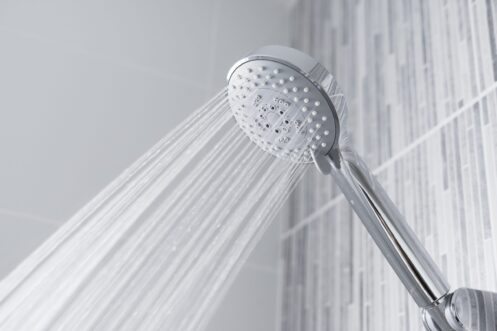
When the water pressure in your home dips, even simple things like washing dishes or rinsing shampoo can become a test of patience. Low pressure can come from more than just clogged pipes or a bad valve; it might point to a bigger issue in your plumbing system.
At Black-Haak, a trusted name in plumbing solutions in Appleton, WI, we’ve assisted numerous homeowners in Appleton in identifying and resolving frustrating water pressure issues. Our experience gives us the insight to help you find the right fix. Pinpointing what’s behind the pressure drop is the first step, and we’re ready to walk you through it.
When the Pressure Drops Without Warning
You might be washing dishes one day with no trouble, then suddenly, the water barely trickles out. A quick pressure drop can be surprising, especially if things were normal just the day before. It may seem minor, but it could point to a deeper problem in your plumbing. The cause could be tied to something as disruptive as a municipal supply issue or as isolated as a single faulty connection in your own home.
Start by checking if the problem occurs throughout your home or in one area. If it’s localized, a specific pipe or fixture could be clogged. If it’s widespread, the issue likely lies deeper in the system. Rust, sediment buildup, or even an unnoticed partially closed valve could be to blame. Pressure doesn’t disappear independently, and the longer you ignore the symptoms, the more likely you’ll face plumbing repairs or hidden damage.
Any sudden loss of water pressure should be taken seriously. It’s not just about comfort; it’s often the first sign that something is amiss in your plumbing system. By acting swiftly, you can prevent the problem from escalating and potentially disrupting your entire plumbing system. Early detection puts you in control, allowing you to take proactive steps to maintain your home’s water pressure.
Hidden Leaks That Drain More Than Water
Low pressure can feel like a slow faucet or a weak showerhead, but what you don’t see is just as important. A hidden leak might not flood your floor, but it still affects how water moves through your pipes. Even a small crack can redirect enough water to lower the pressure you feel at the tap. Over time, that crack lets moisture settle into drywall, flooring, or insulation, which can do real damage without you noticing.
These types of leaks don’t usually leave puddles. Instead, you may see a slight bump in your water bill or a faint drip in the walls. If you notice that your water pressure has steadily declined and has not dropped immediately, a hidden leak could be the reason. You might find mold spots in the corner of a room or peeling paint near baseboards. You might also notice a hidden leak if there’s a musty odor, unexpected damp patches on your walls or ceilings, or a sharp rise in your water bill.
These signs can show up before you even suspect a pipe problem.
The only way to know is to have someone inspect your lines with the right tools. A leak detection professional can use pressure gauges and thermal cameras to find where the leak is hiding. Trying to guess will not stop the loss. Until it’s repaired, your plumbing system will not recover full pressure, no matter what you do above the surface.
Slow Fade of Corroded Pipes
You may not think about what’s behind the walls until something stops working. In older homes, corroded pipes can be a major factor behind low water pressure. Over the years, metal pipes, especially galvanized steel, have begun to rust on the inside. As that corrosion builds up, the space inside the pipe narrows. Less room means less water can pass through, and what once felt like strong pressure starts to weaken.
This change happens gradually, so you may not notice it right away. The water still runs, but not with the same force. Showerheads start to feel weak. Filling the tub takes longer. Washing machines cycle more slowly. The corrosion might also flake off and travel down the line, eventually causing a clog somewhere else in the system. It’s not just the pipes losing volume; it’s the entire system reacting to blocked flow.
Once corrosion begins, there’s no way to reverse it. Cleaning won’t solve it. You need a licensed plumber to assess the layout, check the pipe condition, and replace the worst sections. Ignoring the problem only increases the strain on your appliances and fixtures. The corroded parts can rupture if left too long, turning a slow-pressure issue into a water damage emergency.
How Valves Can Disrupt the Flow
Sometimes, the answer is closer than you think. Every plumbing system relies on control valves to manage the flow of water. These valves regulate pressure and shut water off when needed. But if one isn’t fully open or partially blocked, it can choke your system’s output. A valve doesn’t take much movement to fall out of place. Even minor plumbing work or DIY adjustments can leave a valve misaligned.
If one fixture works fine while another barely delivers a trickle, a valve issue could be the culprit. It might seem like a big deal, but it’s something that can be handled. A plumber can test and swap out the problem parts safely, getting your water pressure back on track without creating more issues.
A professional plumber knows where to check and how to test these components without causing damage. If you’ve ruled out leaks and clogs but still notice low flow, this is the next logical place to look. Replacing or resetting a valve is not complicated, but it requires careful handling to avoid further breaking fittings or disrupting your water supply.
Supply Line Problems Behind the Scenes
Your home’s main water supply line carries all the pressure you rely on. If something disrupts that line, it shows up everywhere, every faucet, appliance, and shower. Tree roots can wrap around underground lines and apply pressure that slowly restricts water movement. A small dent in a copper line can also pinch pressure, even if the pipe hasn’t cracked.
Diagnosing supply line issues takes experience and tools built for underground work. A plumber can trace the main line from your meter and perform a pressure test at the entry point. If the line fails to restore pressure and protect against future breaks, a full replacement might be needed. It’s not the repair you wait for, especially when it connects to every tap you use daily.
Old Fixtures Can Cause Problems
Sometimes, the pipes are fine, the valves are clear, and the water line is steady. But your fixtures are holding everything back. Faucets, showerheads, and washing machine hookups can collect debris, sediment, or mineral deposits. These build-ups create small blockages that reduce pressure right where you need it. You may blame the whole system, but the problem could be at the source.
Fixtures have internal components that wear out, too. Aerators can get clogged, and cartridges inside mixing valves can jam. Over time, rubber washers warp and restrict water flow. These issues don’t always cause dripping or leaks. They just slowly block water until you start to wonder why the kitchen sink doesn’t rinse like it used to.
Before replacing your whole plumbing layout, it’s worth having a professional check the fixtures first. A quick cleaning or a low-cost part swap can bring the full flow back without major changes. If all your fixtures are old, upgrading them can improve water efficiency and pressure. It’s a straightforward fix often overlooked when searching for bigger answers.
Get Good Water Pressure Now
You don’t have to settle for weak water pressure that slows down your daily routine. A few small signs can point to bigger plumbing concerns, and the sooner you act, the easier they are to fix. If you’re ready to get your water flowing the way it should, schedule a visit with Black-Haak today.
We also offer water heater installations, drain cleaning, generator maintenance, and smart home automation.

